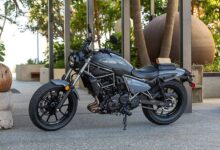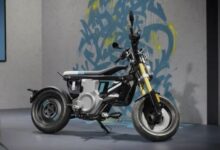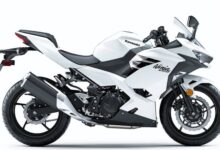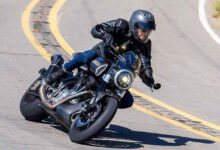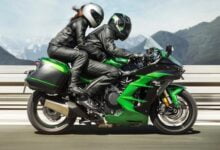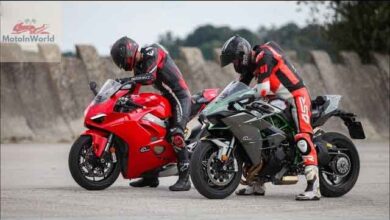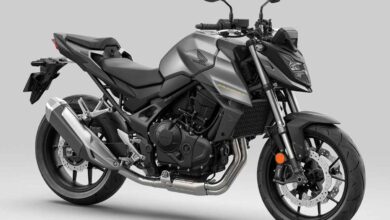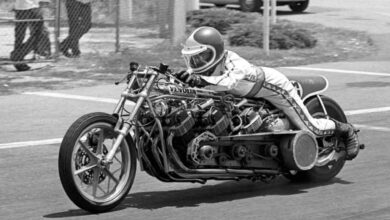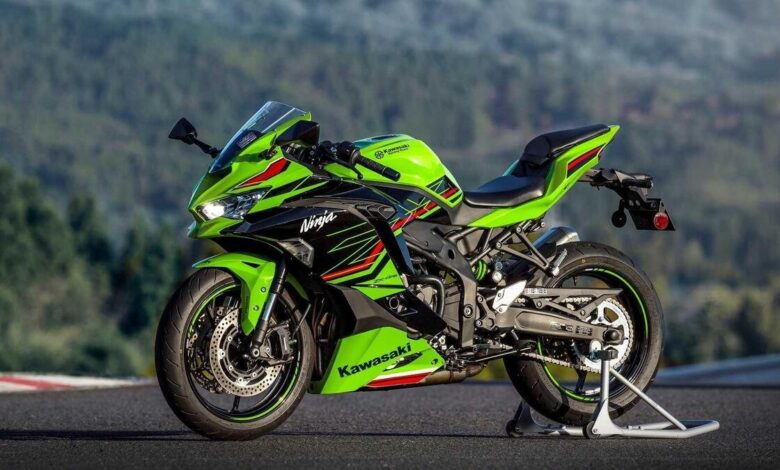
Welcome to our comprehensive review of the highly anticipated 2024 Kawasaki Ninja ZX 4RR. As motorcycle enthusiasts, we understand the excitement surrounding the release of new models. In this blog post, we will delve into the specifications, features, and performance of the 2024 Ninja ZX 4RR, providing you with an in-depth analysis to help you decide if this sportbike is the right fit for you.
Contents
- 1 Design and Aesthetics of the 2024 Kawasaki Ninja ZX 4RR
- 2 Engine and Performance of the 2024 Kawasaki Ninja ZX 4RR
- 3 Chassis and Suspension of the 2024 Kawasaki Ninja ZX 4RR
- 4 Electronics and Technology of the 2024 Kawasaki Ninja ZX 4RR
- 5 Ergonomics and Comfort of the 2024 Kawasaki Ninja ZX 4RR
- 6 Safety Features of the 2024 Kawasaki Ninja ZX 4RR
- 7 Technical Specification of the 2024 Kawasaki Ninja ZX 4RR
- 8 Pricing and Availability of the 2024 Kawasaki Ninja ZX 4RR
- 9 Verdict of the 2024 Kawasaki Ninja ZX 4RR
Design and Aesthetics of the 2024 Kawasaki Ninja ZX 4RR
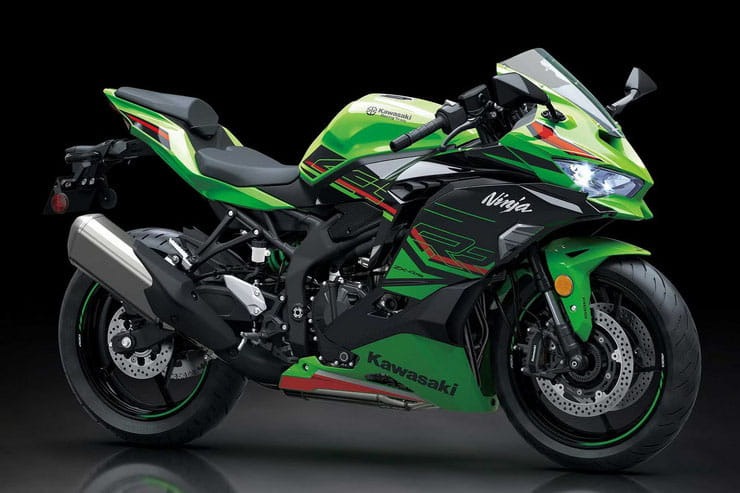
The 2024 Kawasaki Ninja ZX 4RR boasts a sleek and aggressive design that demands attention. The bodywork showcases Kawasaki’s signature lime green color scheme, making it instantly recognizable on the road. The sharp lines and aerodynamic profile not only enhance its visual appeal but also improve its performance by reducing drag. With its compact and muscular appearance, the Ninja ZX 4RR exudes a sense of power and speed.
Back in the late 1980s and early 1990s, there was a brief moment when 400cc four-cylinder sports bikes reached the pinnacle of motorcycle engineering. Honda’s NC30, NC45, and CBR400RR, Kawasaki’s ZXR400, Suzuki’s GSX-R400, and Yamaha’s FZR400R combined superbike chassis specifications with compact dimensions and high-revving engines that showcased Japan’s expertise in miniaturization. Now, after 30 years, this concept is making a comeback with Kawasaki’s ZX-4RR, set to arrive in the UK in late 2023.

With over 75hp available, at least in its most highly-tuned form, the Kawasaki outperforms even the best models from its 1990s predecessors. Yet, its power output remains manageable enough for enjoyable road riding without immediately reaching illegal speeds when you twist the throttle.
At the age of 18 in 1994, I had the privilege of experiencing the latter part of the golden era of Japan’s 400cc four-cylinder sports bikes. It was an incredible time to be a young motorcyclist. From the exquisite Yamaha FZR400RR to the HRC-spec Honda NC30, these compact powerhouses not only resembled the bikes racing in World Superbikes on TV but were also considered true sports bikes by the biking community. Riding a relatively small-capacity and low-powered 400cc machine was not seen as embarrassing at all. In fact, it was admired. These bikes were made for riders.

Of course, many British teenagers were still holding onto their beloved two-strokes. The Suzuki RGV250 and, in my case, the Kawasaki KR-1S were the epitome of naughtiness in the ’90s – Grand Prix replicas that outperformed, outmaneuvered, and yes, let’s be clear about it, out-wheelied anything else on the road. So we divided into two groups, with most of my friends opting for four-stroke motorcycles. And among them, the Kawasaki ZXR400 was perhaps the most popular choice – a pocket rocket filled with attitude and delivering such thrilling fun that I, along with most who experienced it, still yearn for one to this day.
So, ZX-4RR, no pressure then.
Engine and Performance of the 2024 Kawasaki Ninja ZX 4RR
At the heart of the 2024 Ninja ZX 4RR lies a potent 998cc inline-four-cylinder engine that delivers impressive performance. This liquid-cooled powerhouse is capable of producing a staggering 205 horsepower, ensuring exhilarating acceleration and top-end speed. The engine is mated to a six-speed transmission, allowing for smooth gear shifts and precise control.
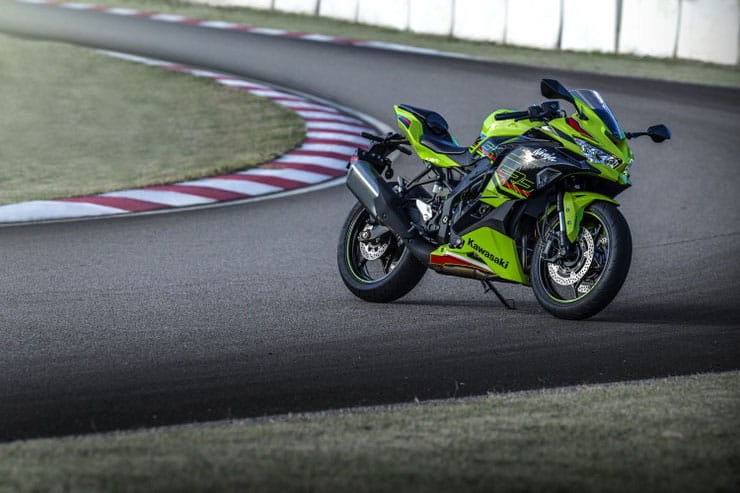
The four-cylinder engine in the ZX-4RR is derived, like the rest of the bike, from the 250cc ZX-25R that has been available in some markets since 2020. Both the bore and stroke are increased, with the bore rising from 50mm to 57mm and the stroke increasing from 31.8mm to 39.1mm.
Like the 2023 version of the ZX-25R, the ZX-4RR has an increased compression ratio – the original 250cc version was only 11.5:1, but it has now risen to 12.5:1, and the ZX-4R’s ratio is 12.3:1. With the additional 150cc of capacity, these changes result in a peak power of 57kW (76.4hp), which rises to 59kW (79.1hp) when the ram air effect is added at speed. However, it is important to note that Kawasaki states that the power level may vary by market, and while it appears that Europe will get the fastest models, some places will receive less powerful variants. For instance, in the USA, the ZX-4RR is restricted to 42kW (56.3hp), and in Australia, the power is limited to 55kW (73.8hp).
The limiting factor seems to be the revs, with Australian models peaking at 14,500rpm and Canadian versions revving no higher than 11,500rpm. In Europe, the ZX-4R is expected to exceed 15,000rpm, and the photos show a red line of 16,000rpm, suggesting that Europe will receive the full 76.4hp. There are four riding modes – Sport, Road, Rain, and Rider-adjustable – each of which alters the bike’s power map and traction control settings. The ZX-4RR also comes with an up/down quickshifter as standard, which is a valuable addition given how frequently you’re likely to use the gearbox to keep that engine revving.
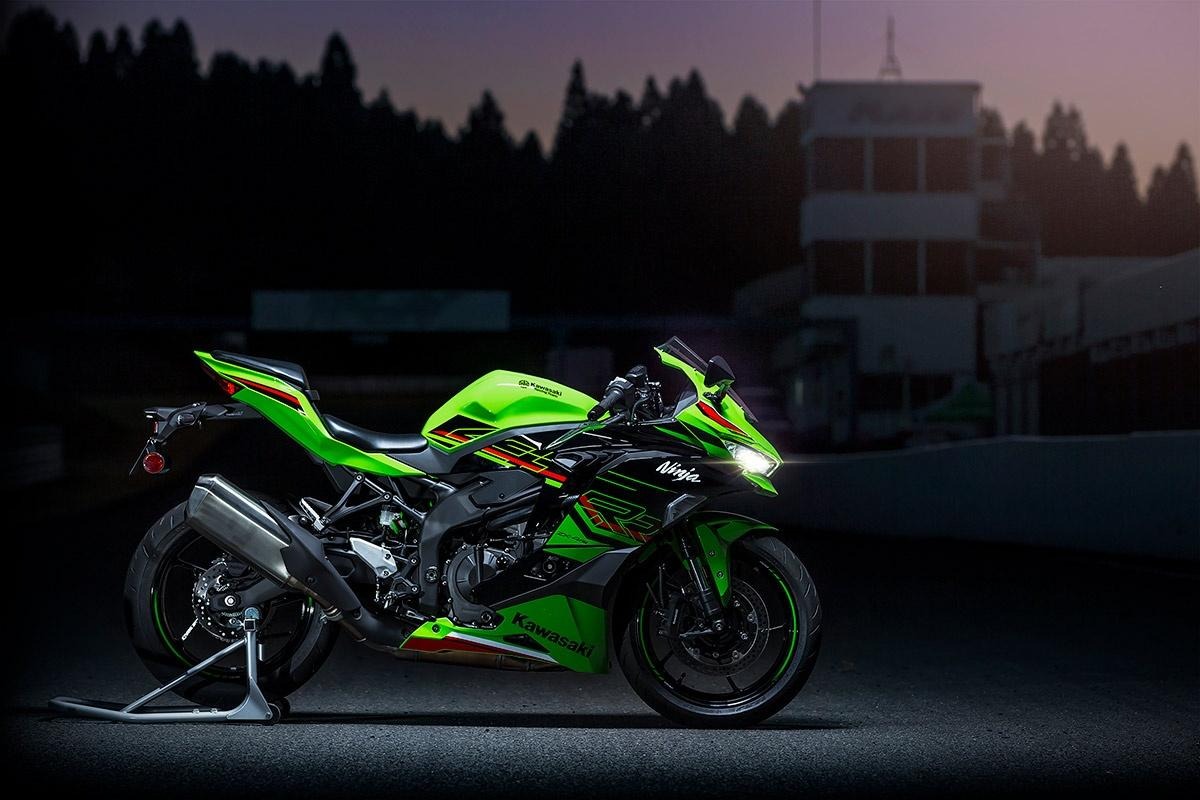
All three versions of the bike come with a 4.3 LCD dash that includes connectivity various display modes, including a ‘track setting that displays lap times and gear position. In the UK, only the top-spec version and full power will be available which equates to a quoted power of 57kW/.4hp @ 14,500rpm, and 58.7kW/79.1hp with ram-air at the same revs. Peak torque, 39Nm/28.8ftlb, is predictably high in the rev range at 13,000rpm. These are impressive figures for a small-capacity Euro5 bike and are far superior to the old ZXR400, which even in a highly tuned and unreliable race spec would only make 75-80hp.
This was a track-only test conducted in the perfect environment of the tight and twisty Calafat racetrack, located one hour from Barcelona. The 2-mile track with a 600m straight was blessed with perfect conditions, and seven long sessions allowed us to fully explore every single rev – all 16,000 of them. With less than 30ftlb of torque and peak power at 14,500rpm, it’s necessary to keep the ZX-4RR at full throttle. Fortunately, there is a super-smooth up-and-down quick-shifter as standard on the RR model that allows you to keep the rev counter above 10,000rpm. The 399cc, 16-valve motor loves to rev and is more than willing to be pushed hard, even allowing for an over-rev between turns. When you occasionally hit the rev limiter at around 16,000rpm, it’s soft and not too intrusive. Ideally, you don’t want to rev any higher than 15,000rpm as that’s just beyond peak power; instead, try to maintain the sweet spot between 10,000rpm and 15,000rpm.
This is not a slow bike by any standards. My ZX reached speeds of 120mph at the end of the 600m straight with plenty of revs left and another gear to go. Under the right conditions, I estimate it should be capable of around 130mph, which would certainly be no joke if you have one of these little terriers behind you on a track day. It’s incredibly rewarding and enjoyable to push the ZX-4RR on the track. You can be reasonably aggressive with the throttle, eagerly winding it to its limit. You don’t have to be cautious with the power in the lower gears like you would on a superbike; instead, stay tucked in and keep those revs climbing.
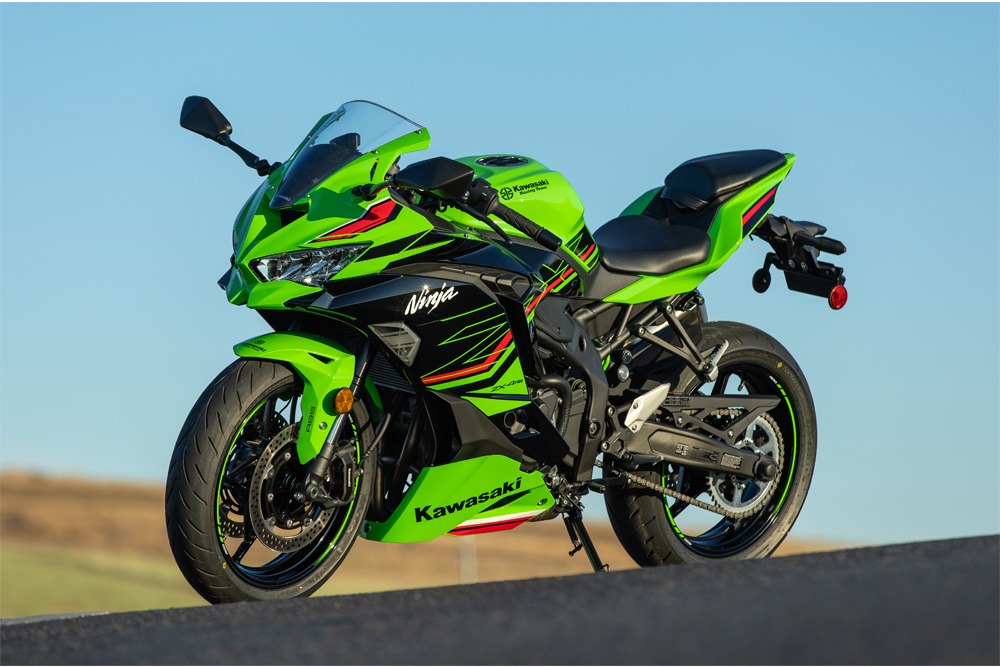
If you get a little too carried away, there is a three-stage traction control system, which is conventional and not lean-sensitive as it uses wheel speed sensors. We had an official accessory road-legal Akrapovic muffler fitted (£914), which added even more desirability to the package as well as a pleasing rasp. I’ve heard the Superteen race version of the ZX-4RR on track during British Superbike tests, and it sounded amazing as it screamed towards that sky-high redline. I can’t wait to hear all thirty identical bikes racing together.
I thoroughly enjoyed riding the ZX-4RR on the track, partly because after seven sessions in blistering temperatures, I wasn’t even slightly fatigued. That’s because the ZX-4RR is so easy to handle; it’s not intimidating at all. You have time to choose your line correctly, spot your braking markers, and get each corner just right. You’re not rushing into corners, scaring yourself on the brakes, and then having to muscle it through the apex. It flows naturally, carries its speed, and then unleashes a symphony of revs and wailing exhaust that makes you feel like you’re setting lap records! Since this was a track-only test, I rarely allowed the revs to drop below 9000rpm.

However, on the cool-down lap, I did play around with the mid-range. It’s not completely lacking in power; you can make progress. But I expect that making a fast getaway from a stoplight will require several handfuls of revs – but that’s what makes it fun, isn’t it? With traction control turned off, wheelies are just about possible in first gear, but you have to be aggressive.
See more: Exploring the Great Outdoors with the 2024 BMW F 900 GS Adventure
Chassis and Suspension of the 2024 Kawasaki Ninja ZX 4RR
To complement its formidable engine, the 2024 Kawasaki Ninja ZX 4RR features a lightweight twin-spar aluminum frame that provides exceptional rigidity and stability. This frame, combined with high-performance suspension components, including fully adjustable front forks and rear shock absorbers, allows for precise handling and superior cornering capabilities. Whether on the track or the open road, the Ninja ZX 4RR offers a responsive and confidence-inspiring ride.

There are three versions of the ZX-4R available, each with slight differences in their suspension specifications. The mid-range ZX-4R SE is equipped with Showa SFF-BP forks, while the ZX-4RR has these forks as well as a Showa BFRC-lite rear shock. However, there is limited adjustability, even with the higher-end suspension components. The SFF-BP forks can only be adjusted for preload and the base ZX-4R does not have any fork adjustment. On the ZX-4RR, the BFRC-lite rear shock adds compression and rebound damping adjustment in addition to preload adjustment.
The steel trellis frame is a departure from the old 400cc fours of the 90s, which typically used superbike-style alloy beam frames. The new frame is nearly identical to the chassis of the ZX-25R, although it has a steeper head angle of 23.5 degrees compared to the 24.3-degree rake of the 250cc bike. The trail is also reduced by 2mm to 97mm, but the wheelbase remains unchanged at a compact 1380mm.
The ZX-4RR weighs 188kg. Interestingly, Kawasaki decided to fit Pirelli Diablo Rosso III tires instead of the standard Dunlop GPR300 that will be used in the UK.
I was also uncertain about what to expect from the ZX-4RR itself, as the original ZXR400 from the 1990s was a fully adjustable mini superbike with impressive handling and a lightweight alloy frame, unlike the new model, which uses a steel frame.
The first two learning sessions were easy and revealed an impressive base package. Manufacturers often compromise on suspension specifications to reduce costs on lower capacity bikes, but this does not seem to be the case with Kawasaki. As I got used to the track, I found the ZXRR to be user-friendly I felt comfortable right away was able to achieve a decent pace from start.
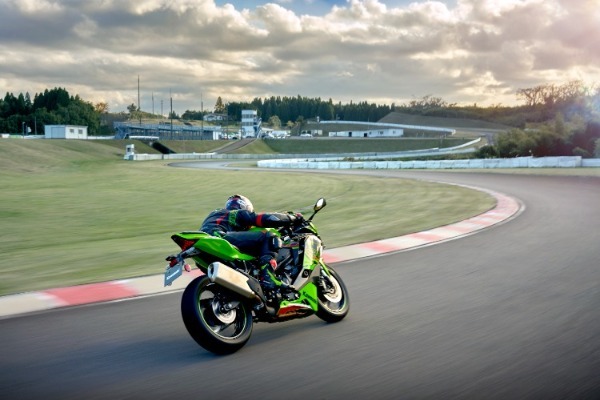
The front-end feeling of the bike was excellent, in quality the benchmark ZX-R and ZX-10R. Kawasaki some suspension adjustments for this track test, adding two turns of preload to the front and maintaining standard preload on the rear shock (horizontal, ZX-10 style), but with 1.5 turns of compression and rebound. These changes were clearly made to accommodate the high temperatures and grippy tires, and I later added another 0.5 turns of compression and rebound damping to the rear to suit my weight. The changes were immediately noticeable, which was a good indication that Kawasaki had not compromised on suspension despite the lack of damping adjustment on the front forks.
With the confidence-inspiring feel from the front end, the ZX-4RR encourages you to release the brakes and enter corners with speed. The steering is light and direct, and the whole bike is delightfully easy to maneuver. Despite its light weight and small size, it tracks accurately without any of the instability one might expect from a lightweight bike, and there is enough room to lean off the inside with your knee slider almost touching the Spanish racetrack. Even when the pegs (with hero blobs removed) start to scrape against the track, you can feel the ZX-4RR providing feedback.
Towards the end of the session, the Pirelli tires struggled with the combination of high temperatures and a slightly heavy rider pushing for faster lap times in an attempt to relive his youth. However, even when the bike slid a bit, it was progressive and not intimidating. It is worth mentioning that the race version on race tires is likely to achieve some surprisingly fast lap times.
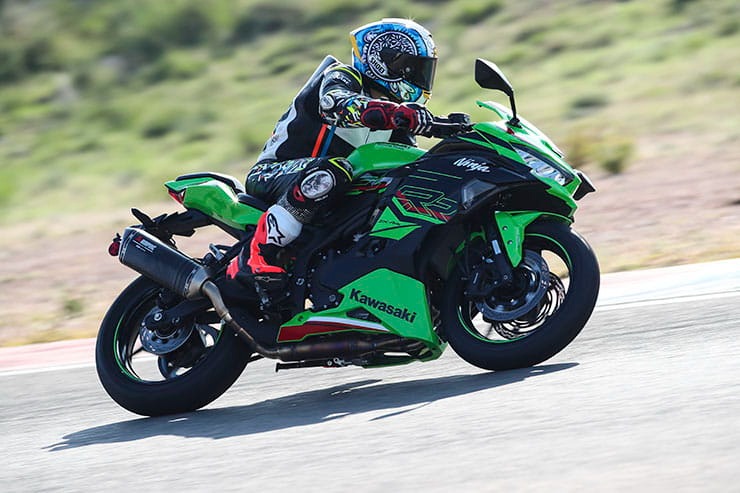
On the road with standard settings, I anticipate that the suspension will be set on the softer side to accommodate new and inexperienced riders. Additionally, I do not think that the Dunlop tires will perform as well as the Pirellis on the track.
Kawasaki Ninja 7 HEV Hybrid Review 2024: The Future of Motorcycling
Electronics and Technology of the 2024 Kawasaki Ninja ZX 4RR
The 2024 Ninja ZX 4RR is a remarkable motorcycle that offers an array of cutting-edge electronics and technological innovations designed to elevate both performance and safety to unprecedented levels. One of the standout features is Kawasaki’s Intelligent Braking System (KIBS), a state-of-the-art technology that guarantees optimal braking power while simultaneously preserving stability, even during intense and abrupt braking maneuvers. This advanced system provides riders with an unparalleled sense of confidence and control, allowing them to push the boundaries of their riding experience without compromising safety.
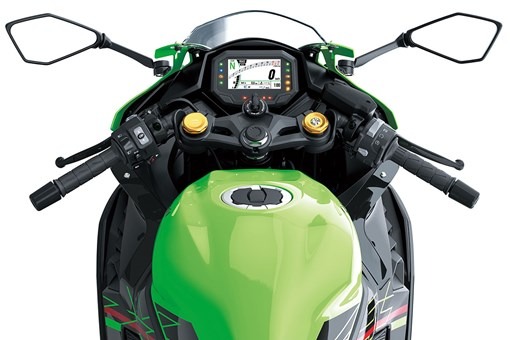
Furthermore, the Ninja ZX 4RR boasts a wide range of riding modes, including Sport, Rain, and Track, each specifically tailored to cater to diverse road conditions. This versatility ensures that riders can effortlessly adapt to various environments, optimizing their performance and enjoyment, regardless of the weather or terrain. Whether it’s the thrilling adrenaline rush of a track day or the challenge of navigating through rain-soaked roads, this motorcycle has got it covered.
In addition to its impressive array of riding modes, the Ninja ZX 4RR also features a quick-shifter that revolutionizes gear changes. With this seamless gear-shifting system, riders no longer need to rely on the clutch for every gear change. Instead, they can effortlessly shift gears with precision and ease, allowing for uninterrupted acceleration and an exhilarating riding experience.
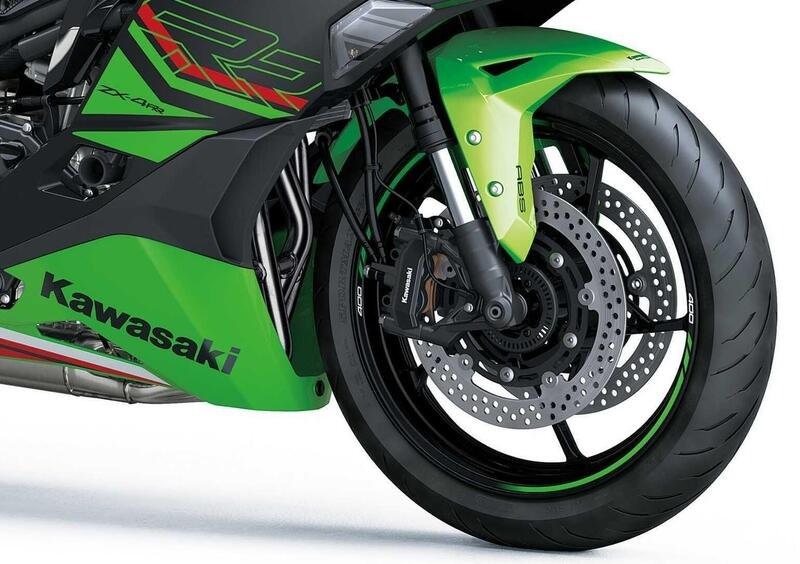
Overall, the 2024 Ninja ZX 4RR is a true testament to Kawasaki’s commitment to pushing the boundaries of motorcycle technology. With its advanced electronics and technology features, it offers riders the perfect blend of performance and safety, ensuring that every ride is nothing short of extraordinary. Whether you’re a seasoned rider looking to take your skills to new heights or a passionate enthusiast seeking the ultimate riding experience, this motorcycle is sure to exceed your expectations and leave you craving for more exhilarating moments on the road.
Ergonomics and Comfort of the 2024 Kawasaki Ninja ZX 4RR
Despite its aggressive nature, the 2024 Kawasaki Ninja ZX 4RR offers a surprisingly comfortable riding position. The ergonomics have been carefully designed to reduce rider fatigue during long rides. The seat provides ample support for both the rider and passenger, and the handlebars are positioned to offer an optimal balance between control and comfort. These thoughtful design elements make the Ninja ZX 4RR suitable for both spirited rides and extended journeys.

The compact dimensions of the ZX-4RR might make it a tight fit for larger riders, with the seat height of 800mm reasonably low for a sports bike. There are no claimed economy figures for the European spec ZX-4RR, which won’t be arriving in dealers until late this year.
However, the fuel tank, at 15 liters, hasn’t been shrunk like the engine, so you can expect a decent range between fill-ups. Since this was a track-only test, it’s hard to judge comfort and long-distance use. However, despite its compact proportions, the ZX-4RR is reasonably roomy.
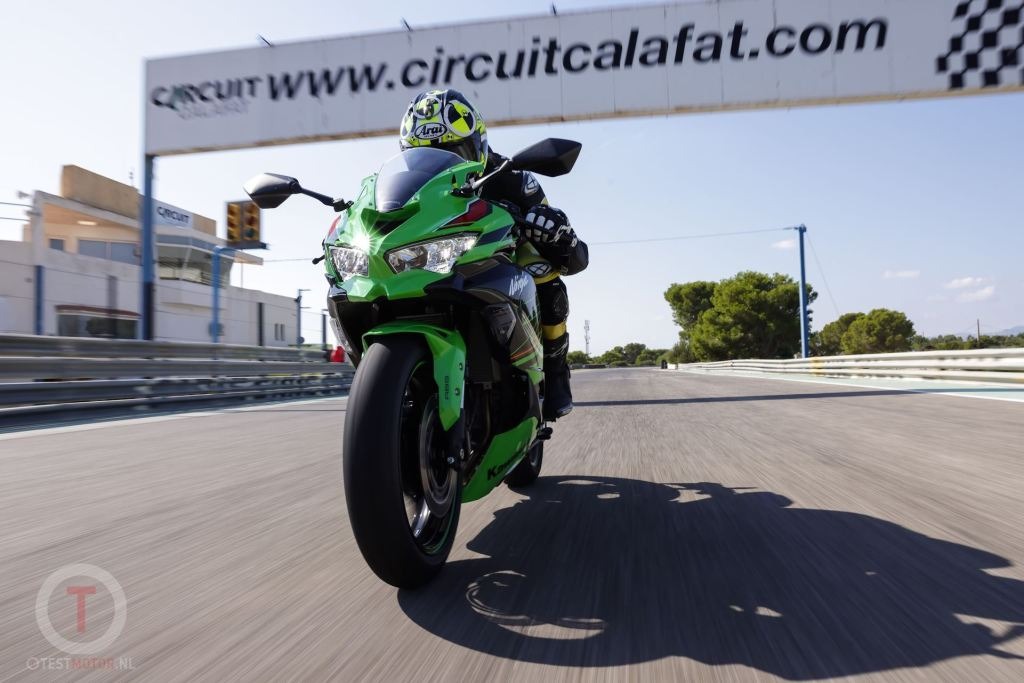
I’m nearly 5ft 7ins and didn’t find it too cramped, and there weren’t many complaints from taller riders on the test. For me, it’s more comparable to a 600cc supersport, certainly larger and roomier than the ZXR400 from the ’90s. The view from the seat is neat: switchgear that, like most Kawasakis, is relatively simple, and a clear 4.3 TFT dash which has connectivity.
There are four riding modes – Sport, Road, Rain, and Rider (manual) mode, which change the power (full or low) and KTRC traction control (levels 1 to 3 and off). There’s an additional Circuit Mode that changes the screen to give a large lap timer and rev counter, which is ideal for track day fun and somewhat addictive. Preload adjustment is on the right-hand 37mm Big Piston Fork.

Styling-wise, the ZX-4RR is very much a baby brother of the Ninja ZX-6R and ZX-10R and could easily be mistaken for one of its bigger siblings. As much as I like the old ZXR400, I equally like the new ZX-4RR. Despite being a small capacity bike, it’s a machine you can be proud of.
Safety Features of the 2024 Kawasaki Ninja ZX 4RR
Safety is paramount when it comes to motorcycles, and Kawasaki has not overlooked this aspect in the Ninja ZX 4RR. Alongside the aforementioned KIBS system, the bike is equipped with traction control, which helps prevent wheel slip during acceleration and cornering. LED headlights provide excellent visibility at night, while ABS ensures reliable braking performance in all conditions. These safety features inspire confidence and allow riders to push their limits with peace of mind.
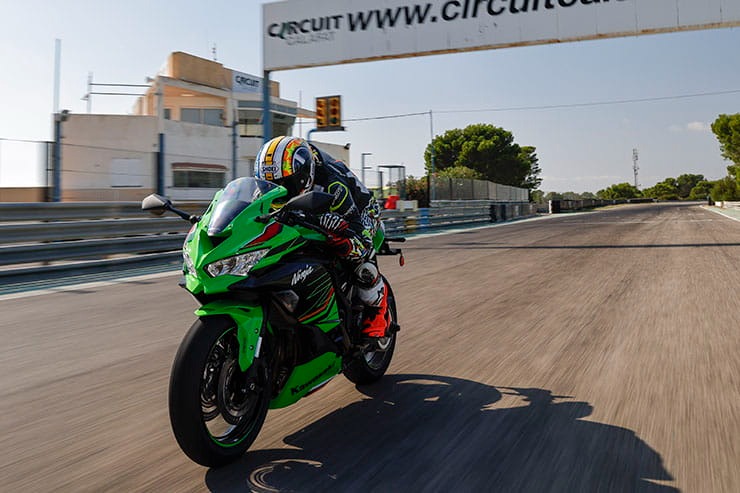
One significant visual distinction between the ZX-25R and the new ZX-4RR is the brakes, with the larger bike receiving dual front discs instead of a single one. They are 290mm discs, each equipped with radial four-pot calipers.
At the rear, there is a 220mm disc with a single-pot caliper, and ABS is present at both ends. The brakes are forgiving and sufficiently strong for some track fun, yet not overly sharp for inexperienced riders. The brake (and clutch) lever is adjustable for span, and even at a decent track pace, the brakes did not feel like they were at their limit and showed no signs of fading.
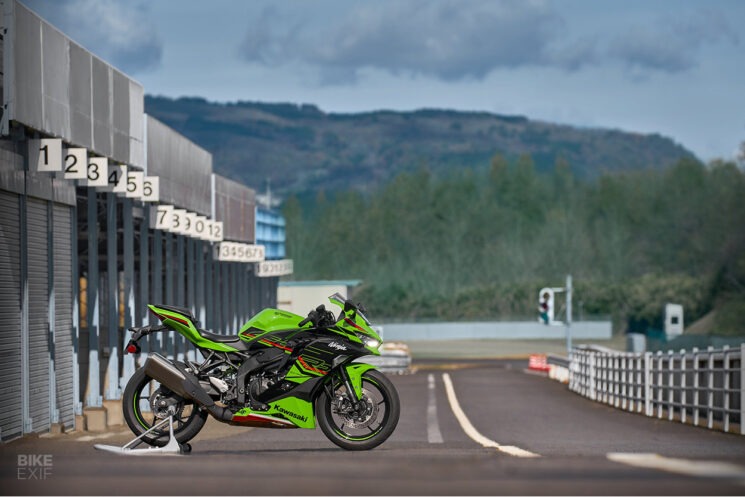
The ABS is conventional and not lean sensitive. Once I began pushing for a fast lap (apologies, the race dash compelled me to do so), it was slightly intrusive, but this is to be expected on an entry-level sports bike. To feel the ABS working near its limit, you have to be pushing for a fast lap, and most track riders never experienced any intervention. I anticipate that you won’t feel it on the road either.
Technical Specification of the 2024 Kawasaki Ninja ZX 4RR
| New price | £8,699 |
| Capacity | 399cc |
| Bore x Stroke | 57mm x 39.1mm |
| Engine layout | Inline four |
| Engine details | 16-valve, fuel injected, water-cooled |
| Power | 77.6bhp (57KW) @ TBA rpm |
| Torque | 26.5lb-ft (35.9Nm) @ 11,000rpm |
| Transmission | 6 speed, chain final drive, optional quickshifter |
| Average fuel consumption | TBA |
| Tank size | 15 litres |
| Max range to empty | TBA |
| Rider aids | Four riding modes, traction control, ABS |
| Frame | Steel trellis |
| Front suspension | Showa upside down forks, 37mm SFF-BP |
| Front suspension adjustment | Preload on SE and RR |
| Rear suspension | Showa monoshock, BFRC-lite on RR |
| Rear suspension adjustment | Preload. Compression and rebound |
| Front brake | 2 x 290mm discs, four piston radial calipers, ABS |
| Rear brake | 220mm disc, one piston caliper, ABS |
| Front wheel / tyre | 120/70ZR17M/C (58W) |
| Rear wheel / tyre | 160/60ZR17M/C (69W) |
| Dimensions (LxWxH) | 1,990mm×765mm×1,110mm |
| Wheelbase | 1,380mm |
| Seat height | 800mm |
| Weight | 188kg (kerb), 189Kg for SE |
| Warranty | TBA |
| Servicing | TBA |
| MCIA Secured Rating | Not yet rated |
Pricing and Availability of the 2024 Kawasaki Ninja ZX 4RR
As of its release in 2024, the Kawasaki Ninja ZX 4RR comes with a price tag starting at $19,999. While this places it in the higher price range for sportbikes, it is important to consider the exceptional performance and advanced features offered by the model. The Ninja ZX 4RR is available at authorized Kawasaki dealerships worldwide, but due to its popularity, it is advisable to check availability in your local area.
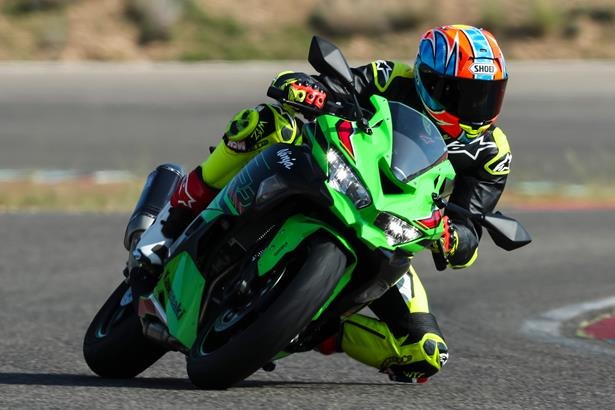
What is the price of the 2024 Kawasaki Ninja ZX-4RR? The price is £8699, which is lower than what most people expected. Initially, there were guesses of £9000 – £10,000 when the announcement was made earlier this year. Interestingly, Kawasaki has already received deposits from customers who were anticipating a higher price tag. While £8699 may seem like a lot of money, it is nearly £2000 less than a ZX-6R, resulting in significant savings. Additionally, quoted PCP prices with a 20% deposit are as low as £105 per month.
In the 90s, there was a decent selection of 400cc machines including some grey imports and models. However, those options no longer available, leaving the competition for rev-happy Kawasaki to come from their own garage in the of ZX-6R or Ninja 650 (£738) or alternatively, Yamaha’s R3 (£6405) or K RC390 (£5699). Although both the Yamaha and KTM are, neither match spec and power of the ZX-4RR With ram-air, the Kawa boasts nearly double the of the Yamaha.
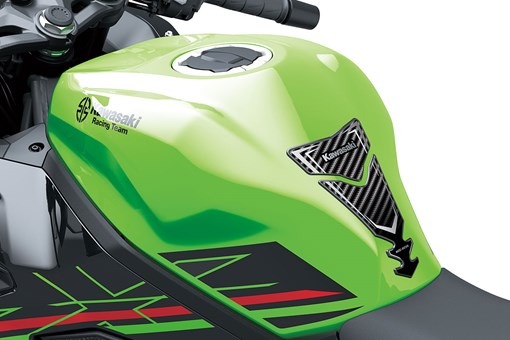
One could argue Yamaha’s R7 (£891). 689cc twin engine offers considerably torque and almost the same power, and it also has an attractive appearance Another contender that cannot ignored is Aprilia’s RS660 While it is more expensive (£9650), it leads the market for small-capacity sports bikes.
Ultimately, the position of Kawasaki’s new ZX-4RR in the market depends on one’s perspective. For newer riders, it can be compared to various bikes, ranging from Yamaha’s beginner-friendly R3 to Kawasaki’s own ZX-6R. On the other hand, for older individuals like myself who remember the original ZXR400 and no longer desire a 200bhp superbike, its rivals could be any of the numerous machines we consider when seeking a new style of two-wheel excitement.
Verdict of the 2024 Kawasaki Ninja ZX 4RR
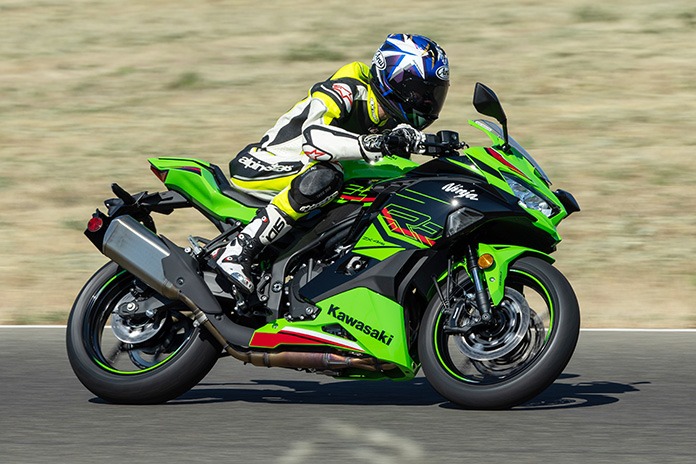
The 2024 Kawasaki Ninja ZX 4RR is a superbike that lives up to its reputation. With its stunning design, powerful engine, precise handling, advanced electronics, and safety features, it offers an unmatched riding experience for motorcycle enthusiasts. While it may come at a higher price point than some of its competitors, the investment is justified for those seeking top-tier performance and cutting-edge technology. Whether you are a track enthusiast or an avid rider looking for an adrenaline rush on the open road, the Ninja ZX 4RR is sure to deliver an unforgettable ride.
The ZX-4RR has some significant shoes to fill (although I recently rode an original ZXR400 from the 1990s and wasn’t overly impressed, such is the march of time and progress). Nevertheless, the new ZX-4RR seamlessly picks up where the original left off and is also neater, faster, safer, roomier, and far easier to ride. Kawasaki has been brave to produce such an unusual bike for the times – it’s the only sports 400 on the market – but I’m pleased they have. I don’t think the ZX-4RR will gain a reputation like the original, but it’s great fun, loves to rev, is easy to ride and forgiving too; new sports bike riders are going to love it.
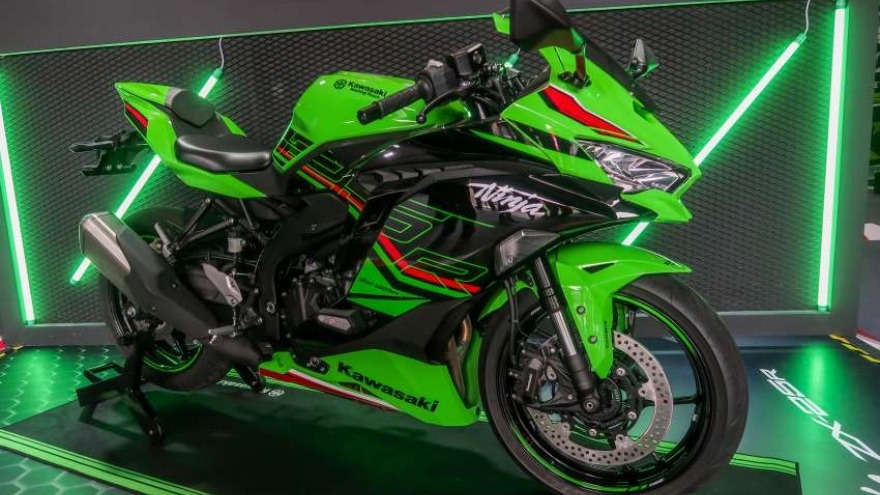
Equally, experienced riders like me can tweak the suspension, just about tuck in behind the low screen, and have some old-school fun. I rode the ZX-4RR on the track all day, rode hard every lap, used all the power, and didn’t feel tired at the end. I can’t remember doing that on any other quality sports bike recently. The small-capacity sports bike is back – thank you, Kawasaki.
See more at: Moto In World
Facebook: https://www.facebook.com/Motobikeinworld
Twiter: https://twitter.com/motoinworld2023
Instagram: https://www.instagram.com/motoinworld/
Pinteres: https://www.pinterest.com/motoinworld/


